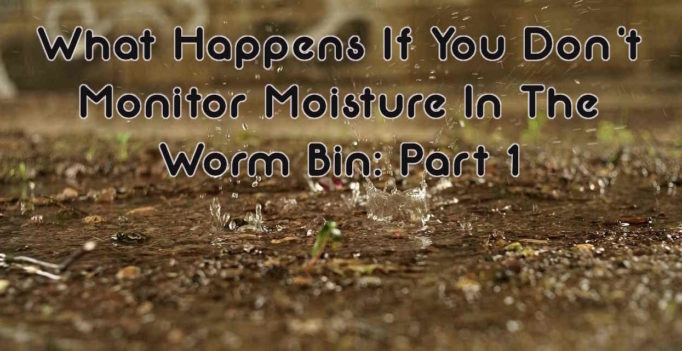Ask any worm composting aficionado. They’ll tell ya’, this worm-driven composting method is as easy as can be! But for all of its simplicity, there are still a few ways to get yourself (and your worms) into trouble.
It’s the silly things. You know, forgetting to feed them, leaving them in the sun, and then there’s this one, forgetting to monitor the moisture in your worm bin. (Hear the foreboding music play in your head. Dun, dun, dun!)
It can be the most menial task, but if forgotten for just a bit, you may be headed for disaster. That’s why this month our focus is on the importance of monitoring your worm bin moisture, and what happens if you don’t.
By the time you finish this article, you’ll be ready for year-round moisture maintenance. Using The Squirm Firm’s resources and troubleshooting tips, you’ll never find your worms stuck underwater again.
What does it matter?
Worms breathe oxygen as we do. However, unlike the inflatable lungs humans have, red wigglers breathe right through their skin. Do you know that thin, slimy covering that kids squeal over? That is what allows oxygen in, carbon dioxide out, and Eisenia fetida’s life to continue.
Proof of the process is seen in how many worms emerge after a good rain. You may be tempted to think that they just really love swimming. Unfortunately, that’s not the case. Worms that surface after rain are trying to ESCAPE.
In too much water, worms drown due to a lack of oxygen. With too little water that slimy mucus layer just drys up. Either way, lack of oxygen causes a worm’s demise. In other words, a worm’s life and death depend on the proper maintenance of moisture in their habitat.
How much is too much?
The answer to this question depends on many factors:
- Air temperature
- Air movement
- Rain
- Amount of water in worms’ food
- Quality of bedding
When it comes down to it, a simple moisture meter probe is all it takes to be certain. But without an accurate measure, moisture in the bin may rise to dangerous levels.
But what if you don’t have a moisture meter? How do you know if you have too much liquid in your bin?
The Dangers of Overly Wet Conditions
If you check your worm bin fairly regularly it won’t take long to notice that things are off. But the longer it goes, the worse it gets. And in this case, the evidence of neglect is particularly unpleasant.
Be on the lookout for these tell-tale signs or you’ll find first hand what happens if you don’t monitor the moisture of your worm bin.
Pooling Moisture
Moisture that sits without draining becomes a stagnant sludge. This leached liquid accumulates to form a swampy little cesspool in your bin. Yuck! Not only is it gross, but it also causes a chain reaction that worsens things in short order.
Aerobic Bacteria Die, and Anaerobic Multiply
The majority of beneficial bacteria in the worm bin are oxygen lovers (aerobic). These microbes are key players in the breakdown of organic matter in the bin. When their oxygen is replaced with moisture, those important bacteria die. Soon, a booming population of (anaerobic) bacteria takes over, doing little to support our worms or the soil we wish to fertilize. And still, there’s more.
Decomposition Becomes Fermentation
Instead of decomposition by microbes that take in oxygen and release carbon dioxide, fermentation occurs. Fermentation is caused by microbes in an oxygen-free environment (anaerobic). Their comparatively slow process results in a release of methane, organic acids, hydrogen sulfide, and other potential toxins.
Sour Bin and Bad Odor
As anaerobic bacteria continue to break down organic compounds in the bin, the putrid smell of decay becomes rather strong. Without ventilation, these gases accumulate, replacing the oxygen and creating an uninhabitable situation for sensitive worms.
Increase in Pests and Pathogens
Unfortunately, not all creatures are as delicate. When too much water cuts off the oxygen, the materials stay cool instead of heating up. This affects the bin in two ways:
- It creates an ideal breeding ground for all sorts of flying, crawling, and creeping pests.
- It eliminates the distinct advantage of nitrogen, oxygen, microbes, and moisture working together to create the heat that kills seeds and pathogens.
Worms Try to Evacuate
Compost worms are hard-wired to react to their environment in ways that ensure the success of future generations. That means if their home is too wet, they’ll try to relocate to a more hospitable place. …If they can.
Some Worms Drown
Red wigglers are not particularly fast-moving, nor can they swim. And unlike common earthworms, compost worms can not survive long underwater. Sometimes they get underwater and can’t get out fast enough. That is when worms drown.
How to Get Ahead of the Problem
When it comes down to it, a simple moisture meter probe is all it takes to be certain. A reading of 80% humidity is a good level to shoot for. Much above that and your worms experience the tell-tale signs above. Much below that sweet spot and your worms fall into a whole new set of dangers. You can look forward to learning more about that next month!
But what if you want to avoid these problems altogether? Smart. An ounce of prevention is worth a pound of cure, right? Thankfully, there is an easy way.
It’s as simple as using a worm bin that takes care of moisture maintenance for you.
Worm Home Solutions
What does it take for a bin to do that? A great big dehumidifier? Nope, just lots and lots of drainage, plus air circulation and attentive care overall.
You can do it yourself by drilling holes all throughout your storage bin habitats, but those usually leak or get clogged. At least that’s been my experience with too much water in holey bins.
When I upgraded from a holey storage tote to a Worm Factory 360 my watery woes went away. And do you know what happens now? If I sometimes forget to monitor the moisture in my stacked tray worm bin, my back is covered. The solutions are built right into the design.
- As warm moist air circulates throughout the system, dry and wet spots become balanced.
- Leachate filters through the layers into a collection tray at the bottom.
- An attached spigot lets me drain the leachate for other uses.
- My worms stay put, hydrated but not drowning, and are kept perfectly safe.
Check it Out
How is your worm bin doing? If you don’t have a moisture meter and you aren’t using a stacked tray system you may want to give it a test. Squeeze a handful of bedding. Dripping, crumbly? Are your worms safe and slippery, or drowning in the depths of a too-damp bin?
By now you know what happens if you don’t monitor the moisture of your worm bin and it becomes too wet. And stay tuned, next month, as I mentioned, you’ll find out what happens when the opposite occurs.
But please, stay ahead of me! Give your worms a fighting chance with a habitat that takes care of moisture maintenance for you! Put them into the high-rise condo made just for red wiggler composting worms, the Worm Factory 360.
Happy worm composting!


I’ve created a false bottom just like I do with my plants’ rocks and a screen. I’m going to buy the factory for better control for harvesting the black gold and the tea.
Timothy, your idea with the false bottom was smart. I bet you’ll love how much easier it all is with a WF360! Let us know what you think about it once you have time to compare you setups! Best of luck!
I have had a worm factory and have been very disappointed. I have never been able to harvest much — the lack of much instruction with it was disappointing. I switched last week to a storage bin system and am hoping for better results. But I have had a huge fruit fly problem, it was in my 360 and I could not get it controlled which is why I switched them out to a new home.
Hi Cynthia. Oh, so sorry to hear you’ve had a disappointing experience! If fruitflies are the issue, the bin is not likely the culprit. BUT that good news because now you can get both up and running without a problem- soon! Fruitflies like it moist and sweet. But if they can’t access that sweetness, they can’t reproduce and keep annoying you. Add a good layer of moist newspaper over the top of your bedding and keep it there until you no longer have those pests flying around. Bury your food so that it’s not even accessible if any get under the paper. And maybe you can lure the seekers away with a cup of vinegar to swim in nearby! Good luck!